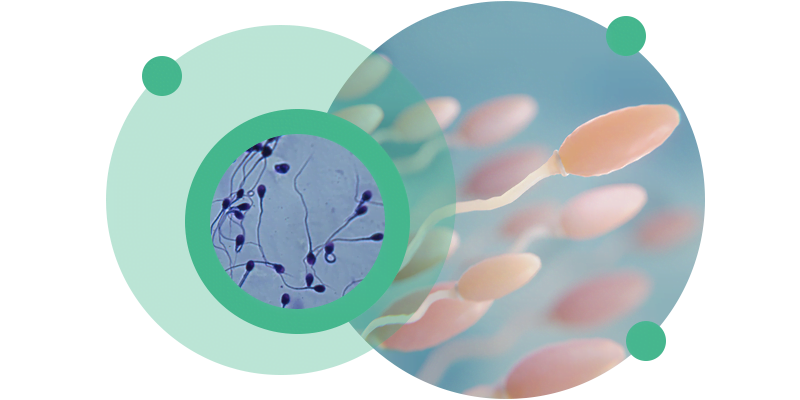Sperm selection
Sperm quality determines the success of assisted reproduction techniques, from fertilisation to embryo development and quality.
The treatment and selection of the most capable sperm are therefore essential to improve the results of MAP treatments, whether in vitro fertilisation (IVF), intracytoplasmic sperm microinjection (ICSI) or intrauterine insemination (IUI).

About sperm selection
During conception, spermatozoa are naturally deposited in the vaginal cavity along with other components of the seminal fluid, and it is during their passage through the female reproductive system, until they reach the fallopian tubes where they will find the oocyte, that the spermatozoa are selected and qualified .
The environment of the vaginal cavity is totally hostile to spermatozoa and will lead to the destruction of around 90% of them. Only a few will be able to continue their journey and reach the cervix.
In the cervix, more specifically in the cervical canal, there is a series of glands which secrete mucus. This mucus is thick and forms a protective barrier against micro-organisms, but also against spermatozoa, for practically the entire menstrual cycle. However, during the period leading up to ovulation, the mucus ceases to be so thick and a mesh is created that allows the sperm to rise, selecting those with normal mobility and morphology. Sperm that manage to overcome this barrier will undergo changes that we call capacitation. These changes allow the spermatozoa to acquire hyperactive motility and enable them to carry out a reaction that is essential for fertilisation: the acrosome reaction. The acrosome is a structure at the top of the sperm head containing enzymes essential for sperm penetration of the oocyte. These enzymes are released during the acrosome reaction.
In cases where MAP treatments are required, sperm selection and qualification must be carried out in the laboratory. To this end, there are several protocols and procedures for processing an ejaculate sample that attempt to mimic the natural process.
The most common sperm selection techniques are swim-up and centrifugation with discontinuous density gradients. These techniques allow the selection of sperm with normal morphology and motility, while the media used help the sperm to become more capable of fertilising an oocyte.
These techniques are used in most cases and with good results, but they still have certain limitations, for example in the case of high fragmentation of sperm DNA. DNA fragmentation may not manifest itself in abnormal morphology or motility, but it will have negative effects on fertilisation and embryonic development. To overcome some of the limitations of more conventional techniques, other methods of sperm selection have been developed. These include IMSI (Intracytoplasmic morphologically selected sperm injection) and PICSI (Physiological intracytoplasmic sperm injection), which complement density gradient centrifugation and swim-up techniques, or MACS (Magnetic-activated cell sorting) and microfluidic plates (such as the Zymot or FertileChip), which can replace the most common techniques for processing ejaculate samples.
This technique involves placing the ejaculate sample in a tube and adding a specific culture medium to the top of the sample. The tube is placed in an incubator with a suitable atmosphere and temperature and at a 45º angle for 60 minutes. During the incubation time, sperm with good motility will be able to reach the top of the culture medium. This fraction of the medium is separated from the rest and used for PMA treatments.
In this procedure, media with different density gradients are used and placed in a tube and covered with the ejaculate sample. The tube is placed in a centrifuge. During centrifugation, spermatozoa with good motility and morphology are separated from non-viable spermatozoa and other cell types present in the ejaculate.
Finally, a precipitate is obtained at the bottom of the tube containing the spermatozoa that have successfully passed through the gradient selection mesh. This precipitate is subjected to two further centrifuges with washing medium and placed to incubate with a culture medium that promotes sperm formation until it is used in PMA techniques.
The density gradient and swim-up techniques are often used simultaneously on the same ejaculate sample to further refine sperm selection. After centrifugation with density gradients and washing, the precipitate obtained is then treated with the swim-up technique, allowing sperm with better motility to be recovered.
IMSI (Intracytoplasmic Injection of Morphologically Selected Spermatozoa)IMSI is a high-definition variant of the intracytoplasmic sperm microinjection (ICSI) technique, in which the spermatozoa are observed at greater magnification under the microscope, allowing the detection of otherwise imperceptible morphological changes.
This technique complements the selection methods already described, but does not guarantee that the sperm selected will have a normal genetic composition, or that they will give rise to normal fertilisation and embryonic development.
PICSI (physiological intracytoplasmic sperm injection)PICSI is another variant of the intracytoplasmic sperm microinjection (ICSI) technique that uses a special plate containing a substance called hyaluronic acid (HA) at certain points on the plate.
During natural conception or in the In Vitro Fertilisation (IVF) technique, hyaluronic acid, present in the cells surrounding the oocyte, plays an important role in selecting the sperm that will fertilise it.
This technique is based on the principle that fertilising spermatozoa have receptors for HA, meaning that they have completed their maturation and are less likely to show changes in their genetic material.
The spermatozoa are then placed on the PICSI plate after treatment with density gradients and/or swim-up. The embryologist selects for microinjection the spermatozoa attached to the points on the plate containing hyaluronic acid that are morphologically normal.
Studies carried out to date show no significant difference in success rates compared with conventional ICSI. However, PICSI could be a useful tool for sperm selection in cases with a high percentage of sperm DNA fragmentation and sperm with abnormal morphology.
Apoptosis, or programmed cell death, occurs naturally to eliminate sperm with abnormalities. This process involves marking the spermatozoa with a substance, phosphatidylserine (PS), available on the outer membrane of the sperm. This substance enables other cells in the testicle and female tract to recognise apoptotic spermatozoa and eliminate them.
When using MAP techniques, some of these barriers are overcome and sperm marked for apoptosis are not eliminated. Conventional sperm selection techniques may not be able to eliminate these sperm as their motility and morphology are not necessarily affected.
This led to the development of the MACS technique, which involves incubating the ejaculate in a column with magnetic particles linked to a molecule, annexin V. This molecule binds to the PS present in the membrane of apoptotic spermatozoa, retaining them throughout the column and separating them from the rest.
This method of sperm selection has not yet produced consensual results in the scientific community, but it could be an option in cases where there is a high percentage of sperm DNA fragmentation.
Microfluidic platesThese relatively new plates, commercially available under the names ZyMot or FertileChip, are based on the ability of spermatozoa to swim actively through membranes or channels. The ejaculate sample is placed in an inlet chamber and 30 minutes later the sperm that has managed to reach the outlet chamber is collected.
This method avoids the centrifuges of more conventional sperm selection methods, reducing the negative effects on the sperm membrane caused by the reactive oxygen species generated in these centrifuges. It also makes it possible to recover a sperm sample with a lower percentage of DNA fragmentation.
As this is a relatively recent method, there are not yet any very conclusive studies on its effectiveness.
Common questions
On the day of treatment, the ejaculate sample is assessed before treatment. After this initial assessment, our embryologists select the best protocol to follow.
In our clinic, the most commonly used techniques are density gradients combined with swim-up.
Sperm selection methods have certain limitations. Particularly in the case of ejaculation samples with altered parameters (concentration, volume, morphology, etc.), a certain amount of caution is required when choosing the protocol to follow. It is therefore essential that the initial evaluation of the sample by the team of embryologists is indispensable.
